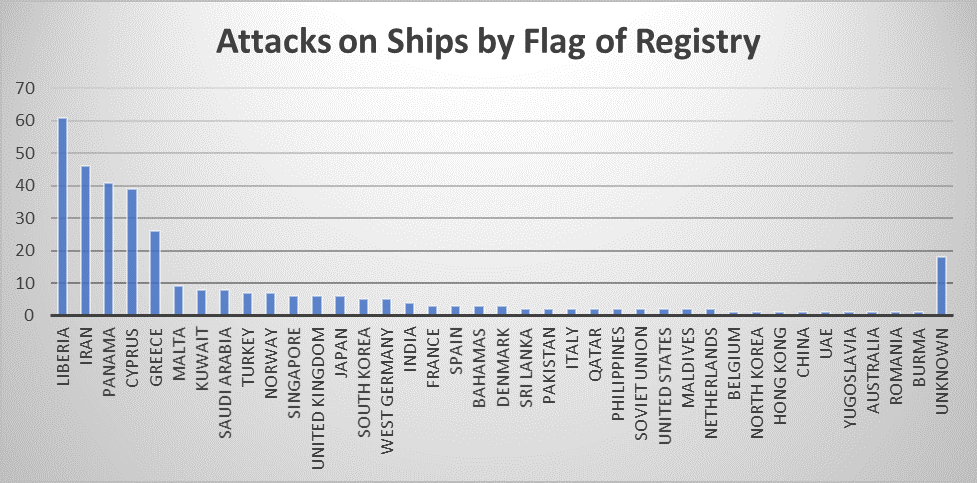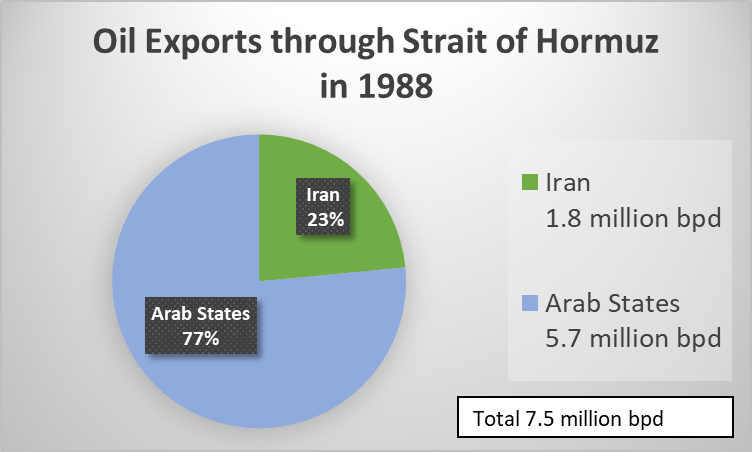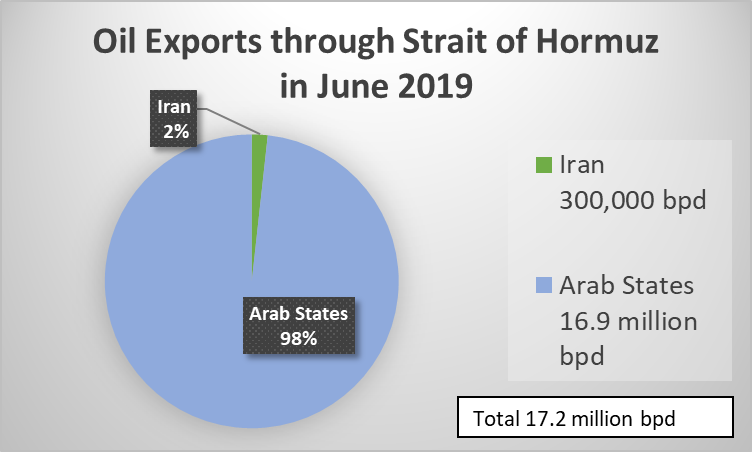By Alex Yacoubian
In mid-2019, tensions in the Persian Gulf echoed the threat to world oil supplies during the eight-year war between Iran and Iraq in the 1980s. In May and June 2019, maritime security deteriorated after the sabotage of six oil tankers in the Gulf of Oman just beyond the Strait of Hormuz. (See timeline). The price of crude rose, briefly, by nearly four percent. Roughly a third of the world’s seaborne oil exports—or a fifth of all global exports—passes through the strait. In 2018, an average of 21 million barrels of oil passed through the Strait of Hormuz daily.
During the Iran-Iraq war, tankers and other ships also became targets. Between 1984 and 1988, a total of 451 ships were hit in the Gulf. The so-called Tanker War was launched by Iraq’s airstrike on Iran’s Kharg Island oil terminus and several Iranian ships. Two months later, Iran began to target ships ferrying oil for Iraq. Commercial shipping initially declined by 25 percent. By 1987, the height of the war, the amount of oil shipped through the Strait of Hormuz fell to less than 4 million barrels per day—down from more than 7 million bpd in 1984. In 1987, to help protect the world’s oil supplies, the United States launched Operation Ernest Will to reflag and escort Kuwaiti tankers ferrying Iraqi oil. At its height, however, the war disrupted less than 2 percent of shipping through the Persian Gulf. Operation Ernest Will lasted for fourteen months—until a U.N. ceasefire ended the fighting.
The following information includes data, graphics and factoids on the two crises over tanker traffic in the Persian Gulf since the mid-1980s.

Sources: U.S. Naval Institute
*Iran attacked Iraq’s southern oil terminus early in the war. Between 1981 and 1984, Iraq attacked ships stopping at Iranian ports, mainly at the northern end of the Gulf. In May 1984, the Tanker War erupted in full after Iraq struck Iran’s oil terminus and several tankers at Kharg Island. Iran retaliated by tankers (mainly Kuwaiti) ferrying oil for Iraq. The war continued for four years.

Source: U.S. Naval Institute
Methods of Attack
Iran and Iraq differed in what they attacked and how. Iraq attacked Iranian merchant ships, mostly tankers, in the so-called “exclusion zone” declared by Iran, which extended forty miles from its shoreline.
- Most of Iraq’s attacks were carried out by missiles fired from aircraft.
- Iraq’s poor targeting, based on radar data, led to the accidental bombing of the USS Stark, which killed 37 U.S. naval personnel.
Iran mainly targeted ships trading with Kuwait and Saudi Arabia, the Gulf countries that provided the greatest support to Iraq. Iranian attacks were generally tit-for-tat responses to Iraqi attacks.
- Iran variously attacked with armed frigates and speedboats, rockets and rocket-propelled grenades, and Silkworm anti-ship cruise missiles. In May 1987, it began laying moored contact mines off the Kuwaiti coast.
- It identified targets using surveillance aircraft or patrol warships.
Toll
The Tanker War was the longest sustained attack on merchant shipping since World War II.
- More than 400 civilian sailors were killed. Hundreds of merchant ships were damaged or destroyed.
- Sixty-one percent of the ships attacked were tankers. Tankers proved more resistant to attacks than other ships. Only 23 percent of the tankers attacked completely sank, while 39 percent of bulk carriers and 34 percent of freighters were destroyed.
Source: U.S. Naval Institute
Global impact
The Tanker War spilled over on ships flagged by at least 38 nations. Ships sailing under the flags of Liberia, Iran, Panama, Cyprus, and Greece suffered the highest number of attacks. The majority of Kuwait’s maritime commerce was shipped under flags of convenience, such as Liberia and Panama.

Source: U.S. Naval Institute
Operation Earnest Will
The United States launched Operation Earnest Will in July 1987 to protect Kuwaiti oil tankers from Iranian attacks in the Persian Gulf. It lasted until September 1988, when a U.N.-brokered ceasefire was declared between Iran and Iraq.
- Operation Earnest Will escorted a total of 127 convoys, or 259 ships, over 14 months. The U.S. Navy deployed twelve ships to the Gulf to support the operation. The operation was directed by the U.S. Navy’s Seventh Fleet, but also involved Airforce AWACS surveillance aircraft and U.S. Army Special Operations Forces.
- It was supported by ships from six European countries, including Belgium, Britain, France, Italy, the Netherlands and West Germany, as follows:
-Belgium: 2 minesweepers
-Britain: 4 minesweepers
-France: 2 minesweepers
-Italy: 3 frigates, 3 minesweepers, and 2 support ships
-The Netherlands: 2 minesweepers
-West Germany: 3 warships
- Each inbound convoy was escorted by two to three naval warships from the Omani coast along the western Persian Gulf to Kuwait. The convoys were supported by U.S. and Saudi AWACS aircraft.
U.S. Confrontations
During the Tanker War, the U.S. military engaged in more than a dozen armed encounters with Iranian forces or Iraqi warplanes. It had three major encounters with Iran:
- Iran Ajr – On September 21, 1987, U.S. surveillance aircraft attacked an Iranian ship laying six mines in the Persian Gulf. A U.S. Army helicopter opened fire on the vessel, killing four Iranian sailors. U.S. Navy commandos then boarded the vessel and detained the surviving crew. Ten mines were found aboard the ship. The incident coincided with then President Ali Khamenei’s appearance at the United Nations General Assembly.
- USS Samuel B. Roberts – On April 14, 1988, the USS Samuel B. Roberts, a naval frigate, sailed into an Iranian mine The captain attempted to reverse the engines and back away but hit a moored mine. The explosion ripped a 21-foot-hole in the port side, nearly ripping the ship in half. Ten sailors suffered severe injuries, but no one was killed. The vessel was towed to Dubai for temporary repairs before returning to the United States. In Operation Praying Mantis, the U.S. Navy destroyed two Iranian surveillance platforms and attacked three ships. It was the largest of five major naval operations since World War II and the first time the U.S. exchanged surface-to-surface missile fire with another country.
- Iran Air Flight 655 - On July 3, 1988, the USS Vincennes, a naval cruiser, engaged in a skirmish with IRGC speed boats after they shot at a U.S. surveillance helicopter. As the Vincennes and IRGC boats exchanged fire, Iran Air Flight 655 departed Bandar Abbas for a regularly scheduled passenger flight to Dubai. The Vincennes mistakenly identified it as an F-14 Iranian fighter jet. The Vincennes fired two surface-to-air missiles, hitting the plane and killing all 290 passengers on board. The Iranian government characterized the incident as a purposeful U.S. attack on civilians.
The U.S. military had one deadly encounter with Iraq, at a time the Reagan Administration was supporting the regime of President Saddam Hussein:
- USS Stark – On May 17, 1987, the USS Stark was conducting a routine patrol in the Persian Gulf 50 miles northeast of Qatar. It was approached by an Iraqi F-1 fighter jet that mistook the U.S. warship for an Iranian vessel. The crew aboard the USS Stark attempted to contact the Iraqi pilot but received no response. The F-1 fired two Exocet missiles at the USS Stark, killing 37 sailors and wounding 21 others.
Operation Sentinel
On July 19, 2019, the Pentagon announced the launch of Operation Sentinel, a “multinational maritime effort.” It said the goals were “to increase surveillance of and security in key waterways in the Middle East to ensure freedom of navigation in light of recent events in the Arabian Gulf region.” The campaign would escort flagged vessels of participating nations in coordination with European, Asian, and Middle Eastern allies. U.S. Central Command also approved the deployment of 500 troops to Saudi Arabia as “an additional deterrent” to Iran.
On July 22, Britain announced a European-led “maritime protection mission” to safeguard international shipping lanes. It vowed to coordinate with the United States but said its initiative would include European countries not contributing to a U.S.-led force. Germany, for instance, announced that it would not take part in the U.S. mission to avoid an escalation of tensions. France, Italy, and Denmark announced support for the British operation. In late July, a second Royal Navy warship, the HMS Duncan, was deployed to the Gulf.
Strait of Hormuz
The Strait of Hormuz is a vital oil chokepoint linking the Gulf of Oman to the Persian Gulf. At its narrowest point, the strait is 21 miles wide, with an international shipping lane of only two miles wide, which forces merchant ships to pass through Iranian and Omani territorial water.
- In 2018, nearly 21 percent of the world’s global oil supplies –or about 30 percent of seaborne oil -- flowed through the Strait of Hormuz.
- In June 2019, 17.2 million bpd transited through the strait, equal to one-sixth of the world’s oil.
- The oil that passed through the Strait of Hormuz in June 2019 was approximately double the total oil production of the United States.
Gulf Oil Exports
At peak production a year before the 1979 revolution, Iran produced 6.5 million bpd. It exported 5 million bpd in 1978. Oil production and exports decreased during the 14-month uprising. Crude oil exports decreased again during the Tanker War. Iran exported 1.71 million bpd in 1983. Exports had dropped to 1.45 million bpd by 1986. Iran’s economy was further troubled when oil prices plummeted by 42 percent between 1986 and 1987.
In 1988, the year the war ended, Iran exported an average of 1.8 million bpd through the Strait of Hormuz, while the Arab Gulf countries exported around 5.7 million bpd.

Source: EIA
In 2018, Iran exported around 1.85 million bpd through the strait, while the Arab states exported approximately 19.2 million bpd.

Source: EIA, OPEC
By June 2019, Iranian exports shipped through the Strait of Hormuz dropped to around 300,000 bpd, largely due to U.S. sanctions. In contrast, Arab Gulf states exported approximately 19.2 million bpd through the strait.

U.S. Reliance on Gulf Oil
- In 1988, the United States imported 1 million bpd from Persian Gulf countries, which accounted for about 22 percent of total U.S. crude oil imports, according to the U.S. Energy Information Administration.
- In 2018, the United States imported 4 million bpd from Persian Gulf countries, which accounted for 18 percent of total U.S. crude oil imports, according to the U.S. Energy Information Administration.
- By mid-2019, 76 percent of crude oil flowing through the Strait of Hormuz went to Asia. As a result, instability in the Persian Gulf had a greater impact on the economies of China and India.
